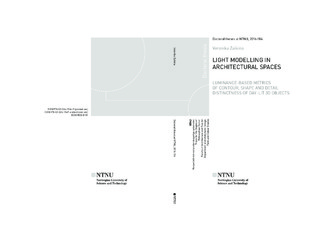| dc.contributor.advisor | Matusiak, Barbara | |
| dc.contributor.advisor | Klöckner, Christian A. | |
| dc.contributor.author | Zaikina, Veronika | |
| dc.date.accessioned | 2016-06-07T08:56:05Z | |
| dc.date.available | 2016-06-07T08:56:05Z | |
| dc.date.issued | 2016 | |
| dc.identifier.isbn | 978-82-326-1547-6 | |
| dc.identifier.issn | 1503-8181 | |
| dc.identifier.uri | http://hdl.handle.net/11250/2391667 | |
| dc.description.abstract | Light modelling is a small but important part of the lighting quality concept. It determines not only the capability of the eye to detect any objects in a space but also its ability to discriminate contours, shapes and details, the most important visual characteristics of any object. These are essential and significant indicators that allow a person to analyse and ascertain another person’s state of health, the freshness of food, the mood of the interlocutor and many other key characteristics of visual environments. Thus, light modelling is an essential aspect important in various architectural spaces, from museums to hospitals to offices.
To date, few studies have been dedicated to light modelling. Some basic knowledge has been achieved from studies on pedestrian visibility and road lighting. However, few investigations have been performed in day-lit interiors. Thus, the light modelling topic remains underestimated and insufficiently studied.
To address this gap, the present research aims to develop the concept of light modelling of real 3D objects in day-lit environments. The author will propose the metrics of contour, shape and details distinctness of the examined units as the most critical aspects of light modelling. Based on the idea that light and colour are mentally inseparable in the human perception of visual environments, it is of great importance to create experimental conditions that provide both of these principal concepts (light and colour). The high dynamic range (HDR) imaging technique will be used as part of the experimental research methodology, giving reliable, analysable, numerical data obtained from luminance maps.
Three experiments and their outcomes form the basis of this dissertation. Work on this dissertation began with general research questions regarding studies of chromatic interiors using HDR images, examining the possible effect of achromatic and chromatic colours and colour combinations on the perception of room illumination (Experiment 1). The focus then turned to the development of the appropriate luminance-based metrics of real 3D achromatic and chromatic objects placed in a room illuminated by daylight (Experiment 2). These metrics were then verified in a real room study and repeated through computer simulation (Experiment 3).
The results obtained from these experiments indicate that majority of the proposed luminance-based metrics correlate very well with subjective assessments that deem contour, shape and details to be distinguishable in different degrees. The metrics also indicate considerable variations among 3D objects with different luminance and chromatic contrasts. These luminance-based metrics outperformed currently used modelling index and cylindrical illuminance metrics. Furthermore, these luminance-based metrics can be used both in real architectural spaces and computer simulations.
Considering these advantages, the author of this dissertation proposes that luminance-based metrics should be recommended for practical use to ensure light modelling; specifically, to better guarantee the distinctness of objects’ contours, shapes and details. The metrics have some limitations dictated by existing experimental conditions and therefore require further testing if they are to be made universally applicable. These will be further discussed in the present dissertation, as will some proposals for possible future research. | nb_NO |
| dc.language.iso | eng | nb_NO |
| dc.publisher | NTNU | nb_NO |
| dc.relation.ispartofseries | Doctoral thesis at NTNU;2016:104 | |
| dc.relation.haspart | Paper 1:
Zaikina, Veronika.
Light level perception in interiors with equiluminant colours. I: Nordic Light and Colour 2012 | |
| dc.relation.haspart | Paper 2:
Zaikina, Veronika; Matusiak, Barbara Szybinska; Kløckner, Christian.
NEW MEASURES OF LIGHT MODELLING. I: PROCEEDINGS of CIE 2014 "Lighting Quality and Energy Efficiency". | |
| dc.relation.haspart | Paper 3:
Zaikina, Veronika; Matusiak, Barbara Szybinska; Kløckner, Christian.
Luminance-based measures of contour distinctness of 3D objects as a component of light modeling. LEUKOS The Journal of the Illuminating Engineering Society of North America 2015 ;Volum 11.(1) s. 31-45
<a href="http://dx.doi.org/10.1080/15502724.2014.981341" target="_blank"> http://dx.doi.org/10.1080/15502724.2014.981341</a>
Copyright © Illuminating Engineering Society | |
| dc.relation.haspart | Paper 4:
Zaikina, Veronika; Matusiak, Barbara Szybinska; Kløckner, Christian.
Luminance-Based Measures of Shape and Detail Distinctness of 3D Objects as Important Predictors of Light Modeling Concept. Results of a Full-Scale Study Pairing Proposed Measures with Subjective Responses. LEUKOS The Journal of the Illuminating Engineering Society of North America 2015 ;Volum 11.(4) s. 193-207
<a href="http://dx.doi.org/10.1080/15502724.2015.1024848" target="_blank"> http://dx.doi.org/10.1080/15502724.2015.1024848</a>
Copyright © Illuminating Engineering Society | |
| dc.relation.haspart | Paper 5:
ZAIKINA V. MATUSIAK B S. (2016) Verification of the accuracy of luminance-based
light modeling metrics by numerical comparison of photographed and simulated HDR
images. - Is not included due to copyright | |
| dc.title | LIGHT MODELLING IN ARCHITECTURAL SPACES: LUMINANCE-BASED METRICS OF CONTOUR, SHAPE AND DETAIL DISTINCTNESS OF DAY-LIT 3D OBJECTS | nb_NO |
| dc.type | Doctoral thesis | nb_NO |
| dc.subject.nsi | VDP::Humanities: 000::Architecture and design: 140 | nb_NO |

